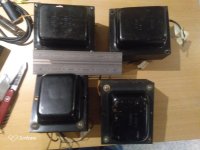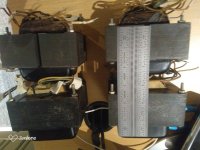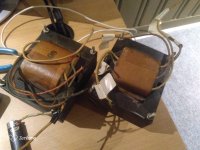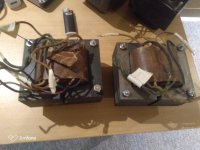I have a set of OTs and a set of PTs from Eico hf-32 mono blocks. Interested more in using for power amp only.
Any thoughts on a good circuit for this iron?
Any thoughts on a good circuit for this iron?
Attachments
Perhaps the best thing to try, is the original circuit for the HF-32.
Just build everything from the right side of the volume control, R24.
Just use a 50k audio taper volume control, not the one in the schematic, and not all that compensation circuit on the left of the volume control.
Consider that the output transformers were specified to work with that circuit, including the global negative feedback compensation.
The global negative feedback compensation, and other compensation parts for the stability of the amplifier, depends on:
C22, C23, C24, C28 and C29; and R27, R29, R30, R31, and R32. Oh . . . and that exact output transformer.
Can anybody attach a screen shot of a 10kHz square wave on an HF-32 to this thread?
I even searched the web for you . . . the schematic:
https://www.thetubestore.com/lib/thetubestore/schematics/Eico/Eico-HF-32-Schematic.pdf
You will need to search for the correct parts list.
Just build everything from the right side of the volume control, R24.
Just use a 50k audio taper volume control, not the one in the schematic, and not all that compensation circuit on the left of the volume control.
Consider that the output transformers were specified to work with that circuit, including the global negative feedback compensation.
The global negative feedback compensation, and other compensation parts for the stability of the amplifier, depends on:
C22, C23, C24, C28 and C29; and R27, R29, R30, R31, and R32. Oh . . . and that exact output transformer.
Can anybody attach a screen shot of a 10kHz square wave on an HF-32 to this thread?
I even searched the web for you . . . the schematic:
https://www.thetubestore.com/lib/thetubestore/schematics/Eico/Eico-HF-32-Schematic.pdf
You will need to search for the correct parts list.
Last edited:
There is a resistor and a bypass cap that are both in parallel with the tube filament.
For a power amplifier, remove the tube and replace with another resistor in parallel with the bypass cap and resistor.
For a power amplifier, remove the tube and replace with another resistor in parallel with the bypass cap and resistor.
Hi Jeff,
The iron on those is pretty good. Great high frequency response. I don't think people realise just how good Eico amplifiers can be. One thing you can do is regulate the B+ for the input stage. A zener will do fine, adjust the dropping resistor value. If you use a CCS to feed the zener., even better
The HF87 does the same thing. I think it's a terrible idea, so when I rebuilt the HF87 I had, I made a heater supply for the 12AX7. Same for the new amp. All they did was save money.Intersting way to bias the output tubes! it looks like theo output tubes power the heater for the phono stage tube.
The iron on those is pretty good. Great high frequency response. I don't think people realise just how good Eico amplifiers can be. One thing you can do is regulate the B+ for the input stage. A zener will do fine, adjust the dropping resistor value. If you use a CCS to feed the zener., even better
They are indeed! I plan on building something worthwhile this winter! The hf32 is of course the no brainer, but thought there might be other interesting designs like the rca sp-20 looks like it might be fun to try!
Attachments
That looks interesting swingarm63.
One thing, the iron won't be a hindrance to sound quality. I wonder if those would work with a single pair of 6L6GC, or 6CA7. Using quads of outputs isn't really something I would do.
One thing, the iron won't be a hindrance to sound quality. I wonder if those would work with a single pair of 6L6GC, or 6CA7. Using quads of outputs isn't really something I would do.
There's that, and matched quads are an issue. Plus two tubes never act as one and I don't think they perform as well. You use quads, sextexts and octals of output tubes per channel for very high power.
I think they were using a quad of 6BQ5 because it was less expensive than a pair of higher power tubes. 6BQ5 outputs make a really nice 12 watt-ish amplifier (Eico HF-81 for example). A pair of 6L6GC makes a wonderful 20 watt amp, and they could be pushed to 55 watts (UL, not that transformer). The same for 6CA7 but with higher heater current.
Look at the heater current for the 6BQ5 in a quad and see how it compares to a pair of 6L6GC, maybe you can swing that. 6L6GC would last a very long time in that light use.
I think they were using a quad of 6BQ5 because it was less expensive than a pair of higher power tubes. 6BQ5 outputs make a really nice 12 watt-ish amplifier (Eico HF-81 for example). A pair of 6L6GC makes a wonderful 20 watt amp, and they could be pushed to 55 watts (UL, not that transformer). The same for 6CA7 but with higher heater current.
Look at the heater current for the 6BQ5 in a quad and see how it compares to a pair of 6L6GC, maybe you can swing that. 6L6GC would last a very long time in that light use.
- Home
- Amplifiers
- Tubes / Valves
- Eico HF-32 mono block iron for project



